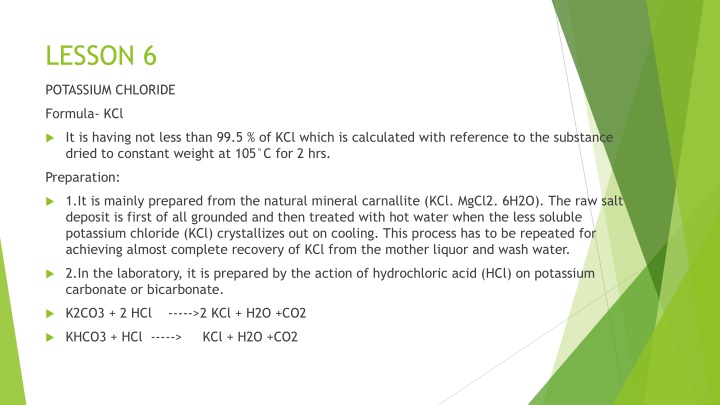
Potassium Chloride and Sodium Chloride Formulas and Preparations
Learn about the formulas, preparations, assays, descriptions, and uses of Potassium Chloride (KCl) and Sodium Chloride (NaCl). Discover how these salts are utilized in electrolyte replenishment and as oral rehydration solutions. Understand the methods for assaying these substances and their distinct properties.
Download Presentation

Please find below an Image/Link to download the presentation.
The content on the website is provided AS IS for your information and personal use only. It may not be sold, licensed, or shared on other websites without obtaining consent from the author. If you encounter any issues during the download, it is possible that the publisher has removed the file from their server.
You are allowed to download the files provided on this website for personal or commercial use, subject to the condition that they are used lawfully. All files are the property of their respective owners.
The content on the website is provided AS IS for your information and personal use only. It may not be sold, licensed, or shared on other websites without obtaining consent from the author.
E N D
Presentation Transcript
LESSON 6 POTASSIUM CHLORIDE Formula- KCl It is having not less than 99.5 % of KCl which is calculated with reference to the substance dried to constant weight at 105 C for 2 hrs. Preparation: 1.It is mainly prepared from the natural mineral carnallite (KCl. MgCl2. 6H2O). The raw salt deposit is first of all grounded and then treated with hot water when the less soluble potassium chloride (KCl) crystallizes out on cooling. This process has to be repeated for achieving almost complete recovery of KCl from the mother liquor and wash water. 2.In the laboratory, it is prepared by the action of hydrochloric acid (HCl) on potassium carbonate or bicarbonate. K2CO3 + 2 HCl ----->2 KCl + H2O +CO2 KHCO3 + HCl -----> KCl + H2O +CO2
Assay: Potassium chloride is assayed by the argentometric titration method called Mohrs method.0.2g sample is first of all dissolved in 50ml of water. Then it is titrated with N/10 silver nitrate solution, using potassium chromate solution as an indicator Each ml of 0.1N silver nitrate solution 0.007455g of KCl. Description: It occurs as colorless prismatic or cubical crystals or as a white granular powder. It is odorless and having a saline taste. It is soluble in water, insoluble in alcohol and solvent ether. It melts at 772 C Uses: It finds use as an electrolyte replenisher. It is also used during hypokalemia or hypochloremia alkalosis after prolonged diarrhea or vomiting. This salt is most widely used for oral replacement of potassium in the form of solution. However, the aqueous solution causes irritation of gastrointestinal tract. It finds use as an adjunct in the treatment of Myasthenia Gravis (severe muscle weakness). It is also a constituent of oral rehydration salt, sodium chloride and potassium chloride intravenous infusion, Ringer s solution, Ringer s injection etc.
SODIUM CHLORIDE Formula- NaCl It is having not less than 99 % and not more than the equivalent of 100.5 % of NaCl with reference to the substance dried at 130 C. It contains no added substances. Preparation: 1.Lab preparation: It is prepared from common salt (impure) in water by passing hydrochloric acid gas. The crystals are precipitated out. 2.Commercial preparation: Industrially it is prepared- a. By evaporating purified saline (sea water) deposits and further purification. b. And by purifying rock salt. Assay: The 0.1g of the substance is dissolved in 50ml of water in a glass stoppered flask. To it ,50ml of 0.1N silver nitrate solution ,3ml of nitric acid,5ml of nitrobenzene and 2ml of ferric ammonium sulphate solution are added. Now the solution is shaken well and is then titrated with 0.1N ammonium thiocyanate solution until the water becomes reddish-yellow. Each ml of 0.1N AgNO3 0.005844g of NaCl
Now-a-days it is analyzed by Volhard's precipitation method with modification. In this method the aqueous solution is acidified with nitric acid, excess of standard silver nitrate is added. Silver chloride gets precipitated. Then nitrobenzene is added and excess of silver nitrate is determined by titrating with standard ammonium thiocyanate using ferric ammonium sulphate as indicator. Nitrobenzene prevents the interaction of silver chloride with ferric thiocyanate Properties: It occurs in the form of a white or colourless powder. It is odourless and having saline (salty) taste. It is soluble in water but insoluble in alcohol. It can be oxidized chemically and liberates chlorine gas. With silver nitrate solution, it gives a white water insoluble precipitate of silver chloride which is soluble in ammonia
Uses: It is a source of both sodium and chloride ions. In the form of injections and infusions, it is used alone or in combination with other salts or glucose when body fluid electrolytes are depleted. Such preparations are used as electrolyte replenishers. Hypertonic solutions are used in conditions when there is excessive loss of sodium along with water. When hypertonic solution is given orally, it induces vomiting and thus can be used in case of poisoning as a first aid. It is a constituent of Ringer s solution, Ringer s injection, sodium chloride and potassium chloride intravenous infusion and oral rehydration salt.
CALCIUM GLUCONATE Formula: C12H22O14Ca.H2O It is having not less than 99.0% and not more than 103.0% of C12H22O14Ca.H2O Preparation: It is obtained either by the oxidation of glucose to gluconic acid in the presence of calcium carbonate or by first getting gluconic acid and then reacting with calcium carbonate to yield the salt. In the former method, oxidation of glucose has been carried out either by bromine or by the electrolytic oxidation in the presence of sodium bromide. In the latter method, the gluconic acid has been generally prepared by the action of various moulds or bacteria of the acetobacter group on glucose. The solution is filtered and calcium gluconate is crystallized from the filtrate.
Assay: It may be assayed by direct complexometric titration method. As the salt is having low solubility in water, it is dissolved by boiling in sufficient water, cooled. The ph is adjusted with sodium hydroxide solution and titrated with standard disodium edetate solution using calcon carboxylic acid mixture as indicator.(BP 1980) As per IP, it may be assayed by complexometric titration involving replacement with magnesium, using 5ml of standard magnesium sulphate solution. The ph can be adjusted with ammonia-ammonium chloride buffer. The volume of disodium edetate equivalent to magnesium sulphate solution is subtracted from total disodium edentate used and then results are calculated. Each ml of remainder of 0.05 M disodium edetate 0.02242g of C12H22CaO14.H2O. Properties: It exists as odorless white crystalline granules or powder. It is tasteless. It is stable in air, but loses its water of crystallization with decomposition at 100oC. Its one gram is soluble in 30ml of water,5ml boiling water and insoluble in alcohol, chloroform and ether. It is incompatible with oxidizing agents and the solution of calcium gluconate gets precipitated by oxalate, borate etc. On adding hydrochloric acid or other acids to the solution, gluconic acid is said to be formed which gets converted easily to d-gluconolactone. Uses: It is a source of calcium ion for treating hypocalcemia tetany or in calcium deficiency. When it is compared to calcium chloride, it is found to be less irritating and can be administered orally or parentally. Calcium gluconate is considered best of all the calcium salts and can be given intravenously.






















